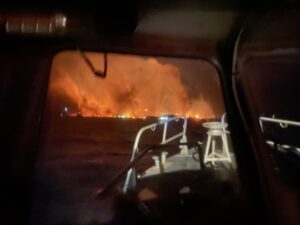
The Coast Guard, along with federal, state, and local partners continue to respond following the Lahaina wildfires in Maui, HI August 9, 2023. The VA considers its efforts to help veterans affected by the disaster “best practice.” Photo by U.S. Coast Guard Petty Officer 3rd Class David Graham
WASHINGTON, DC — With a worsening climate crisis, VA expects to be called upon more and more to implement its fourth mission—to act as a backstop for the nation’s overall healthcare network during times of emergency. That same crisis, however, is predicted to stress VA’s own healthcare network, causing damage to facilities and threatening the health of its most vulnerable patients, according to VA officials.
“Last year’s hurricane season saw three landfalls along the coast of the U.S. mainland, with Hurricane Ian tying for the 5th strongest hurricane ever to make landfall in the U.S. These three storms alone affected 3.2 million veterans and 30,000 VA staff providing care and benefits,” explained Bobbie Small, Jr. the Acting Executive Director of VA’s Office of Emergency Management and Resiliency at a Senate VA Committee hearing last month.
This year also saw devastating wildfires in Maui and wildfire smoke from Canada affecting the health of people far down the eastern seaboard of the United States, as well as many other severe events that impacted the health and wellbeing of millions of Americans.
“These impacts were not equitably distributed,” explained John Balbus, MD, MPH, HHS Deputy Assistant Secretary for Climate Change and Health Equity. “We know that certain populations, such as children, older adults, those with chronic health conditions and disabilities, racial and ethnic minorities, and people experiencing homelessness, are more at-risk of negative health outcomes from climate-related hazards. This is true for both the general population and specifically for veterans.”
While these disasters pose a danger to veterans, they also threaten the stability of the VA healthcare system, Smalls and Balbus told the committee. Some of the problems VA is predicting it will encounter due to climate change include: inundation due to sea-level rise; inland flooding due to severe rain; increased storms, hurricane, and wildfires; drought-related water shortages; fuel disruptions; and more extreme temperatures in summer and winter.
Disrupting Healthcare
“Climate-related extreme weather events and disasters can disrupt healthcare systems at multiple points, creating a surge in healthcare demand, resulting in staffing shortages, affecting critical supply chains, and damaging infrastructure,” Balbus said. “We have seen how health system failures have resulted in loss of life after Hurricane Ida, Superstorm Sandy, and especially Hurricane Maria in Puerto Rico, where roughly 3,000 excess deaths occurred over the four months following the storm.”
A 2022 study found that approximately one-third of hospitals on the Atlantic and Gulf Coasts are at risk of flooding even from relatively weak hurricanes, Balbus added.
“Unfortunately, there has been very little investment in studies like this that highlight future risks, and especially studies that analyze the specific tipping points that caused health systems to fail in extreme events,” he said. “We hope this evidence base can be built to make facilities and systems more resilient and save lives.”
Despite the impact of these disasters on its own system, VA will still be expected to provide emergency assistance nationwide. While COVID highlighted gaps in the nation’s healthcare safety net, it also provided a testing ground for VA to provide assistance to multiple hot spots nationwide while dealing with the same problems at its own facilities.
During the COVID-19 pandemic, VA was given over 200 assignments by FEMA and deployed more than 6,000 volunteers to help minimize healthcare staff shortages nationwide and to train other facilities on proper infection control measures. It also admitted over 500 non-veteran patients into VA facilities when commercial hospitals could not take them.
Much of the assistance VA provides during disasters is through its Disaster Emergency Medical Personnel System (DEMPS), which deploys volunteer clinical and non-clinical staff to an emergency or disaster. Asked if those volunteers are experiencing burnout from increased deployments, Derrick Jastaad, director of VA’s Office of Emergency Management, admitted that VA did stress its DEMPS system during COVID, but that in the last year it has added 1,200 volunteers to its ranks.
He also noted that VA launched the Clinical Deployment Team (CDT) program last year, which included the hiring of 360 clinicians–20 per VISN–who are scheduled for a possible emergency deployment of 30 days twice a year.
“Every month I will have 60 providers ready to deploy in under 72 hours,” Jastaad said. “This is a complementary program to the 12,000 DEMPS volunteers that are still active within our system.”
As for the ability of VA’s own healthcare system to handle emergencies, Jastaad pointed to the Maui wildfires as an example of disaster response done right.
“While absolutely tragic—the loss of life, the loss of infrastructure the loss of property— we were able to identify many promising practices coming out of the response,” Jastaad said. “The fact that we were able to deliver needed medical supplies, prescriptions to our veterans where they were, our ability to track who was picking up prescriptions in order to understand who was still alive and receiving the necessary medicines they require. Our ability to do outreach pre-event, during the event, and after the event through our vulnerable patient care program and our VEText program is unprecedented. Our ability for VA providers that were moving from Oahu to Maui bringing supplies is a best practice.”
